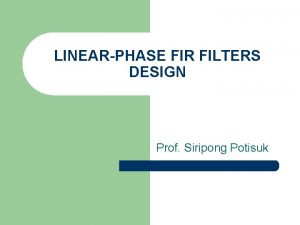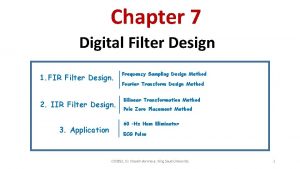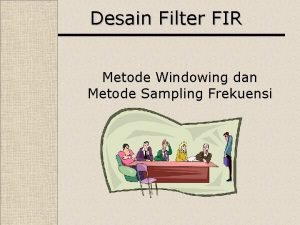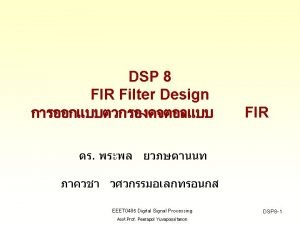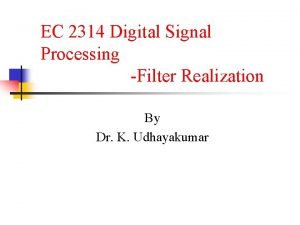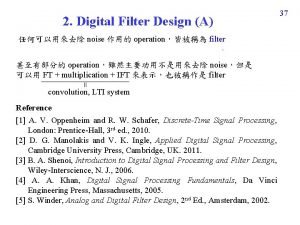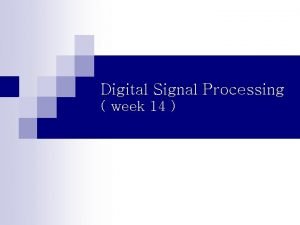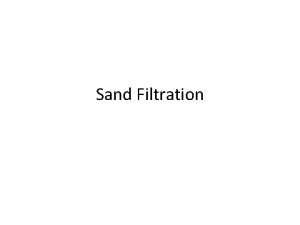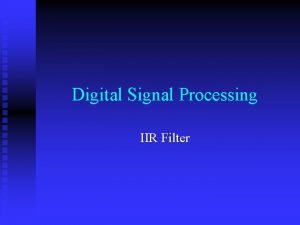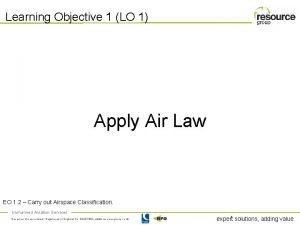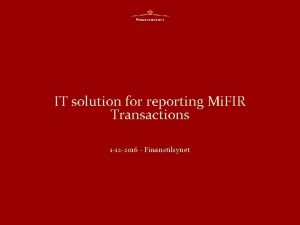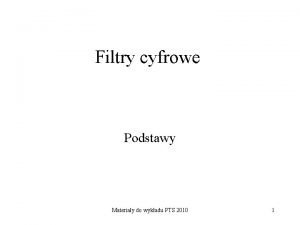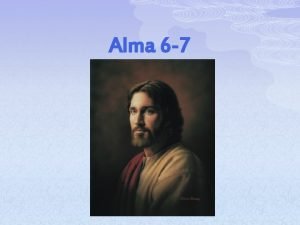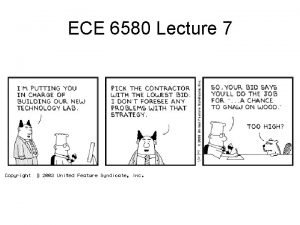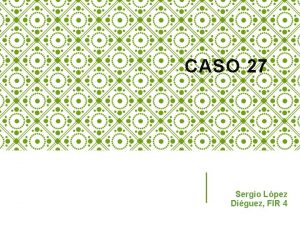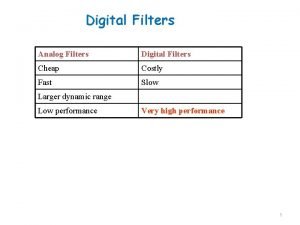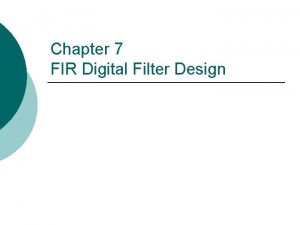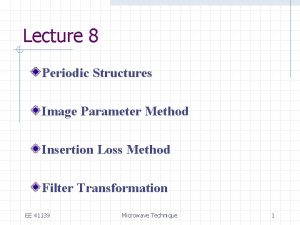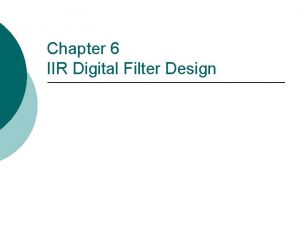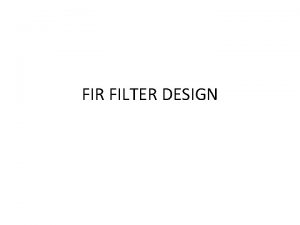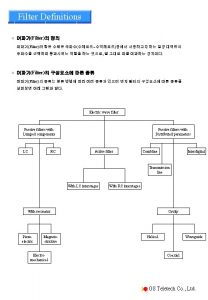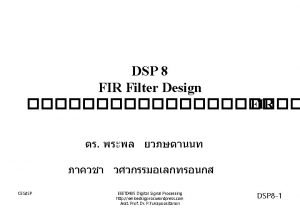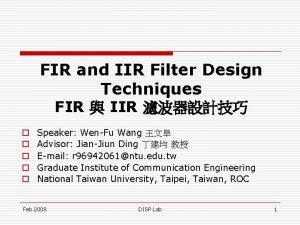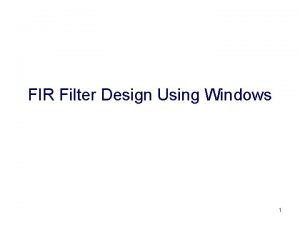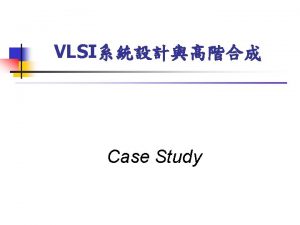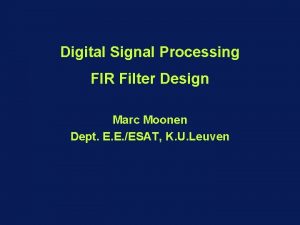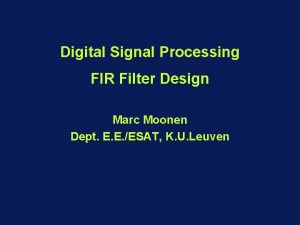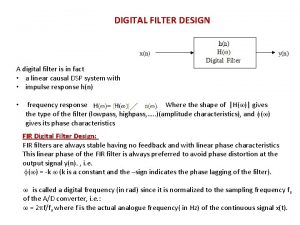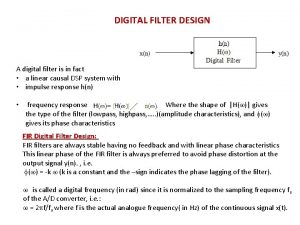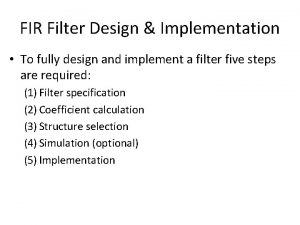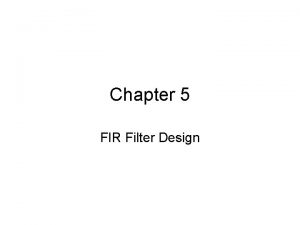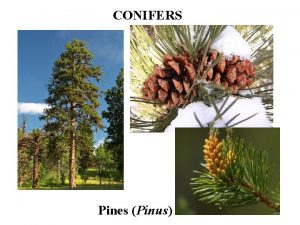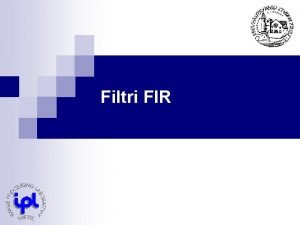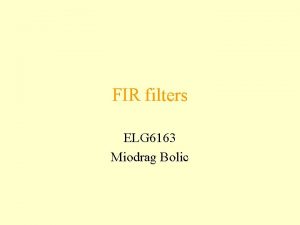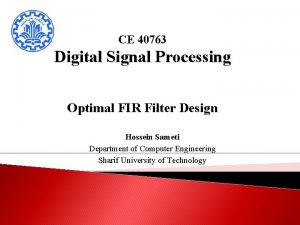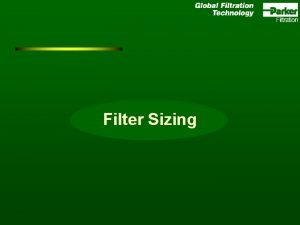Chapter 7 Digital Filter Design 1 FIR Filter





































- Slides: 37

Chapter 7 Digital Filter Design 1. FIR Filter Design. 2. IIR Filter Design. 3. Application Frequency Sampling Design Method Fourier Transform Design Method Bilinear Transformation Method Pole Zero Placement Method 60 –Hz Hum Eliminator ECG Pulse CEN 352, Dr. Nassim Ammour, King Saud University 1

FIR Filter Design Definition: A finite impulse response (FIR) filter is specified by The transfer function of the FIR filter: The difference equation The realization of the FIR filter CEN 352, Dr. Nassim Ammour, King Saud University 2

Fourier Transform Design Method Frequency response of ideal LPF: Impulse response of ideal LPF: Symmetric • To obtain causal FIR filter, h(n) is delayed by M samples. Where, CEN 352, Dr. Nassim Ammour, King Saud University 3

Ideal Impulse Responses for Standard FIR Filters CEN 352, Dr. Nassim Ammour, King Saud University 4

FIR Low Pass Filter Design Example Solution Normalized cut-off frequency 3 -tap filter and filter coefficients From previous slide table compute coefficients and Using symmetry Delaying h(n) by M = 1 sample CEN 352, Dr. Nassim Ammour, King Saud University 5

Example - Contd. b. The transfer function: Causal FIR filter coefficients inverse z-transform c. The magnitude frequency response and phase response Factoring term Using Euler formula Magnitude and phase frequency response CEN 352, Dr. Nassim Ammour, King Saud University 6

Linear Phase If filter has linear phase property (the FIR coefficients are symmetric about the middle coefficient, and the FIR filter order is an odd number), the output will simply be a delayed version of input. M=8 samples delay Let, 17 -tap FIR filter with linear phase property (M=8). M=8 samples delay CEN 352, Dr. Nassim Ammour, King Saud University 7

Nonlinear Phase Input: Linear phase filter output: 90 degree Non-linear phase filter output: Input: Linear phase filter output: 90 degrees phase delay filter output: Distorted! CEN 352, Dr. Nassim Ammour, King Saud University 8

FIR Filtering With Window Method • window functions are used to remedy the undesirable Gibbs oscillations. CEN 352, Dr. Nassim Ammour, King Saud University 9

Problem: Example: Window Method Design a 5 -tap FIR band reject (band-stop) filter with a lower cut-off frequency of 2, 000 Hz, an upper cut-off frequency of 2, 400 Hz, and a sampling rate of 8, 000 Hz using the Hamming window method. Determine the transfer function. Solution: normalized cut-off frequencies 5 -tap FIR 2 M + 1 = 5 then M=2 CEN 352, Dr. Nassim Ammour, King Saud University 10

Example: Window Method –contd Hamming window function Windowed impulse response The transfer function CEN 352, Dr. Nassim Ammour, King Saud University 11

FIR Filter Length Estimation Given the required stop-band attenuation and pass-band ripple specifications the appropriate window can be selected. CEN 352, Dr. Nassim Ammour, King Saud University 12

Problem: Example: FIR Filter Length Estimation Use Hamming window Design a BPF with Solution: Choose nearest higher odd N = 25 Using Matlab for the design Filter type BPF Window type Hamming CEN 352, Dr. Nassim Ammour, King Saud University 13

Application: Noise Reduction We can design a digital filter to remove frequency components (noise) other than the desired frequency range. CEN 352, Dr. Nassim Ammour, King Saud University 14

Application: Noise Reduction CEN 352, Dr. Nassim Ammour, King Saud University –contd. 15

Frequency Sampling Design Method Simple to design The key feature of frequency sampling is that the filter coefficients can be calculated based on the specified magnitudes of the desired filter frequency response uniformly in the frequency domain. Filter length = 2 M+1 Calculate FIR filter coefficients: Use the symmetry: CEN 352, Dr. Nassim Ammour, King Saud University 16

Problem: Example: Frequency Sampling Design Method Solution: Sampled frequencies Hk at the specified frequencies By Symmetry CEN 352, Dr. Nassim Ammour, King Saud University 17

Coefficient Quantization Effect • Obtaining filter coefficients with infinite precision is impossible. • Filter coefficients are usually truncated or rounded off for the application. FIR filter transfer function with infinite precision coefficients: FIR filter transfer function with quantized precision K=tap Error of the magnitude frequency response B=Number of Bits K=tap Example 25 -Tap FIR filter, 8 bit code (sign + 7 bits for fraction Let infinite precision coeff. = 0. 00759455135346 CEN 352, Dr. Nassim Ammour, King Saud University 18

IIR Filter Design Definition: Infinite impulse response (IIR) filter is described using : IIR filter output depends also on the past outputs IIR filter difference equation IIR filter transfer function CEN 352, Dr. Nassim Ammour, King Saud University 19

IIR Filter Design: Bilinear Transformation Method Steps of the design procedure CEN 352, Dr. Nassim Ammour, King Saud University 20

Bilinear Transformation Method Frequency Warping Prototype Transformatio n For LPF and HPF: For BPF and BRF: From analog LPF to desired analog filter Obtained digital filter Transfer Function: CEN 352, Dr. Nassim Ammour, King Saud University 21

Bilinear Transformation Method CEN 352, Dr. Nassim Ammour, King Saud University 22

Bilinear Transformation Method CEN 352, Dr. Nassim Ammour, King Saud University 23

Example 1: Bilinear Transformation Method Design a first-order high-pass digital Chebyshev filter with a cut-off frequency of 3 Problem: k. Hz and 1 d. B ripple on the pass-band using a sampling frequency of 8, 000 Hz. Solution: Digital frequency (rad/s): Pre-warped analog frequency : First-order LP Chebyshev filter prototype: Applying transformation LPF to HPF: Dividing by 1. 9625 Applying BLT: CEN 352, Dr. Nassim Ammour, King Saud University 24

Example 2: Bilinear Transformation Method Design a second-order digital band-pass Butterworth filter with the following specifications: Problem: Solution: Digital frequencies: pre-warped analog frequency: A first-order LPF prototype will produce second-order BPF prototype. CEN 352, Dr. Nassim Ammour, King Saud University 25

Example 2: Bilinear Transformation Method contd. prototype transformation (LPF to BPF): 1 st order LPF prototype: Applying transformation LPF to BPF: Applying BLT: CEN 352, Dr. Nassim Ammour, King Saud University 26

Pole Zero Placement Method Second-Order BPF Design Zeros are placed at z=1 corresponding to DC (zero frequency), and z= -1, corresponding to the folding frequency Pole-zero placement for a second-order narrow BPF. scale to have unit pass-band BPF gain CEN 352, Dr. Nassim Ammour, King Saud University 27

Poles amplitude Determines the 3 d. B bandwidth Pole Zero Placement Method Second-Order BSF (Notch) Design The zeros are placed on the unit circle with the same angles with respect to poles. Poles angle Determines the center frequency scale factor to adjust the BRF so it has a unit pass-band gain Example Design a second-order notch filter with Sampling rate = 8, 000 Hz 3 d. B bandwidth: BW = 100 Hz Narrow stop-band centered at f 0 = 1, 500 Hz CEN 352, Dr. Nassim Ammour, King Saud University 28

Pole Zero Placement Method Pole placed on the real axis First-Order LPF Design Pole placed on the real axis unit pass-band gain scale factor Transfer function Example transfer function of first-order LPF is required to satisfy: unit gain scale factor: transfer function: CEN 352, Dr. Nassim Ammour, King Saud University 29

Pole Zero Placement Method Pole placed on the real axis First-Order HPF Design Pole placed on the real axis unit pass-band gain scale factor Transfer function Example transfer function of first-order HPF is required to satisfy: unit gain scale factor: transfer function: CEN 352, Dr. Nassim Ammour, King Saud University 30

IIR Filter realization Example: Realize the first-order digital high-pass Butterworth filter using a direct-form I realization. Solution: Filter coefficients: DSP equation: Implementation: CEN 352, Dr. Nassim Ammour, King Saud University 31

Application 1: 60 –Hz Hum Eliminator Hum noise: created by poor power supply or electromagnetic interference and characterized by a frequency of 60 Hz and its harmonics. Eliminate the 60 -Hz hum frequency with its second and third harmonics in most practical applications. We can do this by cascading 3 notch filters having frequencies of 60 Hz, 120 Hz, and 180 Hz, respectively. CEN 352, Dr. Nassim Ammour, King Saud University 32

Application 2: ECG Pulse The ECG signal is produced by the electrical activity of the human heart, it is characterized by five peaks and valleys P, Q, R, S, and T. The properties of the QRS complex, (rate of occurrence and times, heights, and widths, provide information to cardiologists concerning various pathological conditions of the heart. CEN 352, Dr. Nassim Ammour, King Saud University 33

Heart Beat Detection Using ECG Pulse • Initial corrupted ECG data (with 60 -Hz interference and its 120 and 180 Hz harmonics, and muscle noise). • The 60 -Hz interference and its harmonics of 120 and 180 Hz have been removed • Result after the band-pass filter • Original ECG signal occupies the frequency range from 0. 01 Hz to 250 Hz (used for diagnostic-quality ECG). CEN 352, Dr. Nassim Ammour, King Saud University 34

Example: EGC Signal pre-processing Problem: Design the ECG signal pre-processing system for heart beat rate detection Solution: 60 -Hz eliminator design (notch frequency of 60 Hz) CEN 352, Dr. Nassim Ammour, King Saud University 35

Example: EGC Signal pre-processing -contd transfer functions and the difference equations Frequency responses of three cascaded notch filters. CEN 352, Dr. Nassim Ammour, King Saud University 36

Example: EGC Signal pre-processing -contd The second-stage design using the BLT CEN 352, Dr. Nassim Ammour, King Saud University 37
 Type 1 fir filter
Type 1 fir filter Fir filter applications
Fir filter applications Filter fir adalah
Filter fir adalah Lpf hpf bpf
Lpf hpf bpf Direct form 2 structure
Direct form 2 structure Digital filter design
Digital filter design Digital filter design
Digital filter design Perbedaan rapid sand filter dan slow sand filter
Perbedaan rapid sand filter dan slow sand filter Blt method will convert analog filter to dt filter that has
Blt method will convert analog filter to dt filter that has Residual chlorine
Residual chlorine Pronarea fir ezeiza
Pronarea fir ezeiza London fir
London fir Fir uir
Fir uir Moment of inertia composite shapes
Moment of inertia composite shapes Ehd42
Ehd42 Fir filtri
Fir filtri Fir agency
Fir agency Taiga biome
Taiga biome Fir transactions
Fir transactions Vertical limit
Vertical limit Transformacja biliniowa
Transformacja biliniowa Alma 7:11–13
Alma 7:11–13 Fir rendszer
Fir rendszer Stger
Stger Port fir
Port fir Fir de contentie
Fir de contentie Tree in ling
Tree in ling Fir c
Fir c Diguez
Diguez Fungsi digital filter
Fungsi digital filter Optimum notch filter in digital image processing
Optimum notch filter in digital image processing Analog vs digital filter
Analog vs digital filter Digital filter
Digital filter Insertion loss method
Insertion loss method Bilinear transformation iir filter design
Bilinear transformation iir filter design Webench filter design
Webench filter design Doc tf media
Doc tf media Bakki shower filter
Bakki shower filter
